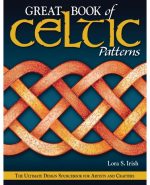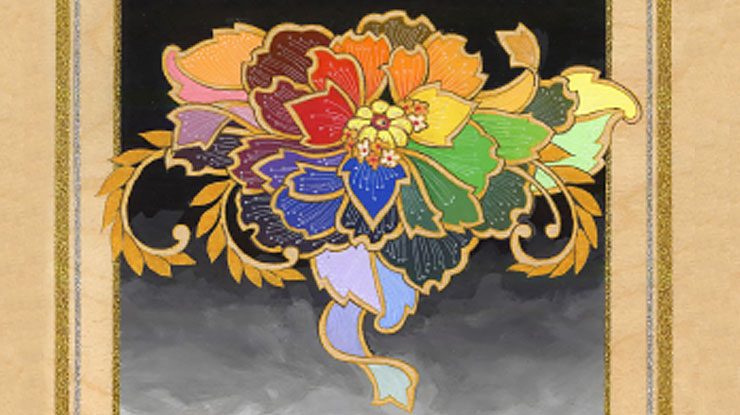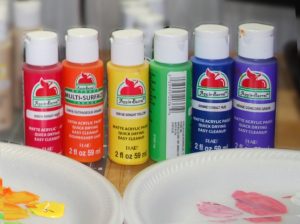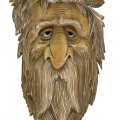Learn color theory—and make a beautiful project—with just five paints
By Lora S. Irish
Overwhelmed by the paint aisle? Not sure of the difference between yellow-orange and orange-yellow? Completely confused when people talk about primary and secondary colors? This project will answer those questions by helping you create a beautiful, lasting reference you’ll be proud to hang in your workshop or home. Best of all, you only need three colors—red, blue, and yellow—plus some black and white to mix all of the colors you need.
Check below for the list of supplies, and then scroll down to download the PDFs. You need all five PDFs; one long document was broken into pieces for easy downloading. The pattern is in PDF #5.
Materials & Tools
General Supplies
Wax-coated paper plates or styrofoam plates
Palette knife
Water: 2 bowls
Paper towels
Paintbrushes: flat shaders, assorted sizes #4 – #10
Frisket film: 12″ (30.5cm) square (Self-adhering, removable plastic film used for masks and stencils. Click here for more info.)
Birch plywood: 12″ x 18″ (30.5cm x 45.7cm)
Sandpaper: 220 grit
Brown kraft paper: 6″ (15cm) or 8″ (20cm) square
Graphite tracing paper
#2 pencil
Painter’s tape or masking tape
Craft knife, bench knife, or chip-carving knife
Craft Paint
(Any brand is fine. See below for an explanation of paint colors)
Cadmium red
Cadmium yellow
Ultramarine blue
White
Black
Gel pens: assorted
Paint Colors: Professional Names vs. Craft/Hobby Names
The list of color names in the supply list are the traditional artist-quality, professional color names. Most paint manufacturers use the chemical-based name for their artist color lines, whether those colors are acrylics, watercolors, or oils. So the manufacturer will name their pure hue red Cadmium Medium Red for each different line of paint.
Craft paints, made for the hobby market, have their own specific names for their hues, tones, and color shades depending on the manufacturer. One company may call the pure hue red color Fire Engine Red, while another names the same color Apple Red, and a third might name theirs Candy Cane Red. When you purchase your craft colors, please refer to the manufacturer’s color chart, which shows all of the colors in that line of paint. Chose the purest hues possible, regardless of the name of any particular paint color.
I worked my project using the Apple Barrel craft paint line manufactured by Plaid. These colors are inexpensive and readily available. My local WalMart carries several lines of Plaid craft paints.
From left to right:
20501E Bright Red = Cadmium red
21961E Outrageous Orange = Cadmium orange
20513E Bright Yellow = Cadmium yellow
20361E Bright Green = Chromium oxide green
20596E Cobalt Blue = Ultramarine blue
20595E Concord Grape = Dioxide purple
20503E White
21885E Jet Black
Note: I use orange, green, and purple (the three secondary colors) often enough that I include premixed bottles in my regular paint kit. You don’t need them for this project, however; we will create them by mixing red, yellow, and blue (the primary colors).
CLICK HERE to download Part 1 of the Color Wheel Project PDF.
CLICK HERE to download Part 2 of the Color Wheel Project PDF.
CLICK HERE to download Part 3 of the Color Wheel Project PDF.
CLICK HERE to download Part 4 of the Color Wheel Project PDF.
CLICK HERE to download Part 5 of the Color Wheel Project PDF.
 Lora S. Irish is a professionally trained artist who specializes in projects using natural materials, including wood, leather, gourds, and fabric. Using those materials as inspiration, springboard, and surface, she carves, paints, woodburns, embroiders, scrapbooks, and makes jewelry and, more recently, soap. Lora has written 28 books on crafting and offers free tutorials, patterns, and projects on her blog, LSIrish.com. Her patterns are available for sale at ArtDesignsStudio.com.
Lora S. Irish is a professionally trained artist who specializes in projects using natural materials, including wood, leather, gourds, and fabric. Using those materials as inspiration, springboard, and surface, she carves, paints, woodburns, embroiders, scrapbooks, and makes jewelry and, more recently, soap. Lora has written 28 books on crafting and offers free tutorials, patterns, and projects on her blog, LSIrish.com. Her patterns are available for sale at ArtDesignsStudio.com.
 Want more from Lora S. Irish? CLICK HERE to see her books and magazine articles available from Fox Chapel Publishing.
Want more from Lora S. Irish? CLICK HERE to see her books and magazine articles available from Fox Chapel Publishing.









